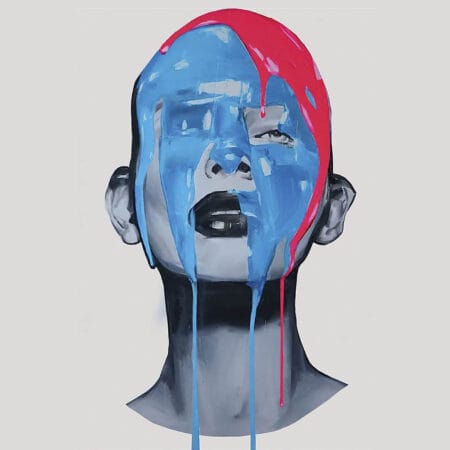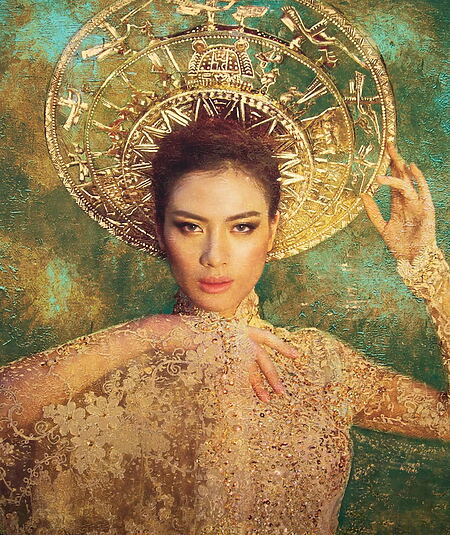Art constant change for centuries , which is repeatedly initiated by social changes or technological progress (see Impressionism in response to the invention of photography ) .
For a few months now, the evolutionary jump in artificial intelligence in the art landscape has been clearly noticeable. , AI art has been on everyone's lips and, on the one hand, ensures considerable profit expectations, on the other hand for severe uncertainty and fears under creative.
Recently, the copyright debate about artificially generated art and the rights to generative AI Art and the use of image generators once again worked out when a US judgment fell a pioneering judgment.
The fact is that art created by artificial intelligence unexpectedly makes its way into the art world and produces an unprecedented flood of AI images that were completely created by her-works of art without human creator.
No wonder that a lot of questions arise. Let's try to answer the most common for you shortly:
What exactly is AI Art ?
These are works of art that have arisen from the support of artificial intelligence. In contrast to traditional art, in which artists create a work with their own hands, the work here is created by artificial intelligence.
AI Art has been an increasingly popular topic for several years. Théâtre D'Opéra Spatial recently caused a stir on the net because it took first place in an art competition.
In today's world, AI art is mostly thought of digital images that are designed on the computer and, if necessary, printed out later or printed on canvas. But the possibilities of artificial intelligence are not limited to painting. also be used in other art areas such as sculpture , music or architecture.
How does AI work in art?
The creation of art by artificial intelligence is an interesting phenomenon that is now possible through special programs.
A well -known tool that is used is stable diffusion . Other programs such as Midjourney , Crayion or Dall-E 2 enable the creation of impressive images.
These so-called text-to-image generators only need a brief description of the desired image content in order to be able to generate a variety of possible images.
The use of artificial intelligence creates unique works of art that impress in a gentle and calm way.
What is a AI image?
Until recently, the creation of images and graphics required extensive knowledge of image processing using Photoshop and similar tools.
But since the emergence of Canva , the paper has turned, and artificial intelligence has revolutionized the market for graphic and image design. Using AI-based image generators, breathtaking images can be created in no time without expertise .

An image generator based on AI is a kind of artificial intelligence that is able to create new pictures in a unique way or to work on existing ones. The AI tool uses extensive data to identify patterns and create visual masterpieces on this basis. This application is extremely versatile and extends from realistic portraits to abstract works of art and subtle drawings.
What is the difference between a AI and an AI?
It has certainly occurred many times that they have read about artificial intelligence and have come across the abbreviations AI and AI . But what do they actually mean and are there differences between them?
The answer is surprisingly simple: AI is the abbreviation for artificial intelligence stands for the English spelling "Artificial Intelligence"
Ultimately, it is the same concept. You will find AI more often in German -speaking countries, while AI is more common in the English -language context.
How can AI art can be seen?
Thanks to AI algorithms, it is possible to realistically imitate existing images and recognize patterns and characteristics. Generative Adversarial Networks (GAN) used here
, compared to traditional photos, AI-generated images some distinguishing features , such as a lack of shadows or unnatural perspectives and body shapes avoid misinformation or manipulation by AI-generated images ( deep fakes
AI-generated images exhibit some significant differences from conventional photos. In particular, color intensity is often more pronounced, and colors appear richer and more vibrant.
There are also differences in contrast AI-generated images often have a higher contrast range than conventional photos.
In addition, AI-generated images are often sharper because they are based on a higher number of pixels . However, it is important to note that AI-generated images can sometimes appear unnatural because they are based on an algorithm and not on an actual motif.
Another distinguishing feature is the shadow play , which is often more natural in conventional photos and is based on actual lighting conditions, while it can be more irregular and unnatural in AI generated images.
Also note the precise body proportions on images generated by AI. Sometimes the AI has difficulty portraying hands and feet equally realistically and symmetrically. As a rule, the faces are very smooth and perfectly symmetrical.
An effective method to find AI-generated pictures is the use of tools such as Google Reverse Image Search .
Here, the image is uploading, whereupon the search engine compares it with millions of pictures in your database in order to filter out similar results.
If the uploaded image is an artificial creation, it may be that no matches are found or the results are not in line with the image. A likely indication that the image may have been artificially generated.
Are AI images protected by copyright?
As soon as the artificial intelligence is able to create your own content through training with various works, questions about copyright law arise. Is it possible that applications such as Chatgpt, Midjourney, Dalle-E or Lensa can be considered the author of works?
Under Section 2 (2) UrhG, it is clear:
Works in the sense of this law are only personal mental creations.
Only human creators can create copyrighted works. Artificial intelligence cannot therefore be viewed as the author. Likewise, users who make an inquiry to a AI application are also the creator of the content.
Even if technical aids such as cameras or image processing programs are allowed, the human proportion of the result must be crucial.
Can artificial intelligence be really creative?
Prof. Dr. Sebastian Stober -professor of artificial intelligence at the Otto von Guericke University Magdeburg-has a strong confidence in the ability of artificial intelligence (AI) to be creative. The researcher from Magdeburg explains that for him creativity means taking a new perspective - and that the AI is quite able to achieve this independently.
In an FKT interview, he takes a position to the creative skills of AI and their limits as follows:
I think AI can be creative. Creativity means combining things that had not to do with each other beforehand. For me, creativity means taking a new perspective - AI can do that independently. In this respect, it can be inspiration for new approaches. This becomes even clearer in the field of art. If I look at art in its original form, then I always have someone who wants to express something with it. That doesn't make artificial intelligence. AI can create a soundtrack for a home video in the background. This is the art of utility - without the aim of creating something in itself or formulating a certain statement as an artist. ”
Where can you find artificial intelligence in everyday life?
Although the development of artificial intelligence is still in its infancy, it is already present in many areas of our everyday life. We often come into contact with her, especially when picking up the smartphone Numerous apps use algorithms , which, strictly speaking, are not directly connected to the AI.
They only describe a if-then process that reacts to a specific action by the user. But the AI goes one step further. It is a special collection of algorithms that are able to react to unforeseen events and unstructured data. In contrast to other algorithms, she can classify and process them.
A well -known example of the use of AI in everyday life is the facial recognition of your smartphone , as is the case with Apple's Face ID. This biometric method enables your face to be recorded three -dimensional by using infrared technology and a projector with 30,000 infrared points.
In this way, all characteristics of your face are recorded and compared with the stored data by algorithms. So you can make sure that only you can access your cell phone if you unlock it by facial recognition.
Another excellent example of the use of artificial intelligence (AI) in everyday life is digital voice assistants such as Siri or Alexa . These intelligent tools are used if, for example, you need a directional description to a certain restaurant in which you want to lunch or want to call up a weather forecast for your planned weekend trip.
The AI-supported language processing and language generation of Siri, Alexa, Cortana or Google Home enables this assistant to provide you with the information you want quickly and easily and to support you in everyday life.
Netflix cannot do without the use of artificial intelligence . If you use the popular streaming service, AI is used to propose films or series that you might like. For this, your previous visual habits are analyzed, which leads to an extremely personalized process.
The time and programs are taken into account, which you usually look at at this time. About 80 percent of the films and series seen on Netflix are influenced by AI.
The 10 most important AI applications at an overview
- Mobile phone with facial recognition technology
- Social Media
- Emails or messages
- Google Search
- Digital voice assistant
- Smart home devices
- Pendulum traffic
- Bank business
What are 4 types of artificial intelligence?
The world of artificial intelligence is divided into four categories that relate to the ability to perceive their surroundings, to develop their self -confidence, to remember their past and their ability to improve based on learning processes.
The first two types, also known as Artificial Narrow Intelligence (ANI) , have already been realized.
The two more advanced types three and four form the Artificial General Intelligence (AGI) and the Artificial Super Intelligence (ASI) .
The development of the AGI and the ASI is still in full swing, but they have the potential to be as smart as or even smarter than humans.
Here are the 4 guys at a glance:
- Type 1: Artificial intelligence with reactive machines (reactive machine)
- Type 2: Limited storage capacity (Lim. Memory)
- Type 3: Theory of the Spirit or Mindevil (Theory of Mind)
- Type 4: Self -perception (self -awareness)
Further information on this is technical, scientific and philosophical nature. These would go beyond the framework of this article. You can find a good first point of contact at Audius - KI: Your guide to the 4 types of artificial intelligence .
Source directory:
In addition to the sources already listed in the article, we used the following information offers to answer these questions:
- Garnance of value - what is AI Art ? These are the most important facts , https://www.wertgarantie.de/ratgeber/elektronik/ Unterheshalt-freitzeit
- Mind verses - this is how you recognize AI generated pictures! , https://www.mind-verse.de/post/so-kerken-sie-ki-gener-bilder
- Urheberrecht.de - Artificial Intelligence (AI) in Copyright: What are the rights? , https://www.urheberrecht.de/kuenstlich-intelligenz/
- XING - Artificial intelligence in everyday life: The 10 most important AI applications at an overview , https://www.xing.com/news/insiders/articles/kunstliche-intelligenz-im-alltag-die-klüchtsten-ki-Kendungen-im-uberblick-3861076

Owner and Managing Director of Kunstplaza. Publicist, editor, and passionate blogger in the field of art, design, and creativity since 2011. Successful completion of a degree in web design as part of a university program (2008). Further development of creativity techniques through courses in free drawing, expressive painting, and theater/acting. Profound knowledge of the art market through many years of journalistic research and numerous collaborations with actors/institutions from art and culture.

















